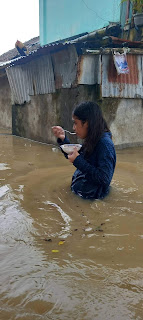 |
| Map traces storm's track. (Pagasa photo) |
Tropical Storm Paeng (international name: Nalgae) ravaged the Philippines tonight, its rains causing floods and landslides that left 45 people dead and billions worth of damage to crops and other properties, and it will be felt in Hong Kong starting tomorrow.
According to the Hong Kong Observatory, it expects to raise Standby Signal, No. 1 between Sunday night and Monday morning (31 October) as the storm moves at 18 kilometers per hour through the Central China Sea.
 |
| Worst hit was Maguindanao, where most of the casualties were caught in raging floodwaters |
The storm’s
rainclouds are expected to cause rainshowers tomorrow and drench Hong Kong by
Monday.
 |
| PINDUTIN PARA SA DETALYE |
 | |
|
“Under the combined effect of Nalgae and the northeast monsoon, it will be windy over the territory early to midweek next week. Winds will be strong offshore,” the Observatory said. “In midweek next week, winds on high ground may reach gale force…. The Observatory will closely monitor the development of Nalgae and the northeast monsoon.
 |
| Residents of Camarines Sur eat while submerged in floodwaters |
Storm Nalgae
is being closely monitored by Hong Kong because of heavy clouds that can cause floods
and landslides, the main causes of 45 deaths recorded so far in the Philippines
and hundreds of millions of pesos in damage to crops, as well as public and private properties.
Philippine
authorities are considering the declaration of a one-year national calamity
because of such damage.
 |
| PINDUTIN PARA SA DETALYE |
 |
| MAY CHANCE KA PANG MANALO! |
The National Disaster Risk Reduction and Management Council (NDRRMC) reported that 16 out of 17 regions in the country were assessed as high risk for Paeng, with Western Visayas and Bicol regions suffering the most damage.
The
NDRRMC said that of the 45 persons killed, 40 were buried by landslides in
Maguindanao del Norte.
 |
| Rescuers try to dig up a victim from the mud in Maguindanao (FB photo) |
This
prompted President Ferdinand “Bongbong” Marcos Jr, presiding over the NDRRMC
emergency meeting, to ask why the affected residents were not immediately evacuated.
 |
| Press for details |
 |
| PINDUTIN PARA SA DETALYE |
“I would like to start with the flooding in
Maguindanao, simply because we have to already look at it dahil ang daming
casualty (because there are many casualties),” he lamented.
“So
maybe if we could start with there first, just to give me a better idea of what
happened, what caused the flooding and bakit hindi natin sila na-evacuate at
nagkaganyan ang casualty, napakataas? (why we were not able to evacuate them
and the casualties came to this, to many),” he added.
In other
regions, local government units brought residents of vulnerable areas to
evacuation centers.
In Bicol,
at least 15,426 families or 72,089 individuals were brought to evacuation
centers, according to Gremil Alexis Naz, spokesperson of Office of Civil
Defense–Bicol. Of the total, 15,296 families were in evacuation centers while
130 families were in shelters outside government facilities.
In
Negros Occidental, 2,435 families with 9,607 individuals stayed in evacuation
centers, Provincial Social Welfare Officer Merle Garcia reported.












